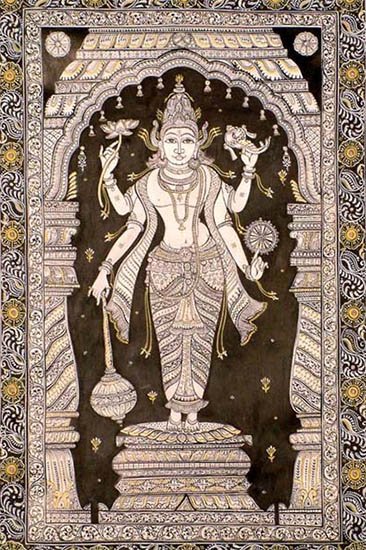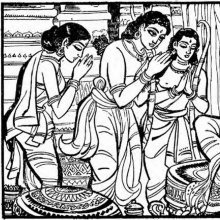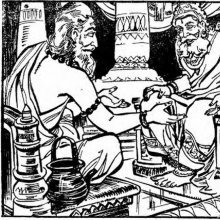Sumitra, Sumitrā, Su-mitra: 22 definitions
Introduction:
Sumitra means something in Buddhism, Pali, Hinduism, Sanskrit, Jainism, Prakrit. If you want to know the exact meaning, history, etymology or English translation of this term then check out the descriptions on this page. Add your comment or reference to a book if you want to contribute to this summary article.
Images (photo gallery)
In Hinduism
Shilpashastra (iconography)
Source: Wisdom Library: Elements of Hindu IconograpyAnother attendant of Subrahmaṇya is called Sumitra. His story is given thus in the Kumāra-tantra. There once lived a good brāhmaṇa named svarṇākṣa in Kāśi; he had a son named Sumitra who had been worshipping Skanda in due form during his three consecutive births. Subrahmaṇya was pleased with his devotion to himself (Subrahmaṇya) and gave him the name Sumitra (a good friend) and made him the head of the gaṇas and gave him a place near him. Then follows a description of the image of Sumitra; Sumitra should be sculptured according to the uttama-navatāla measure, with two eyes, two arms and a red complexion. He should have a fine looking face and should be youthful possessing side-tusks. The head should be covered with a karaṇḍa-makuṭa hiding his tuft of hair or a jaṭā-makuṭa. The right hand should carry the śakti and the left hand should be kept on the hip (kaṭyavalambita). Or, the hands may be kept in the añjali pose on the chest. He may be sculptured either as seated or as standing on a padmāsana.

Shilpashastra (शिल्पशास्त्र, śilpaśāstra) represents the ancient Indian science (shastra) of creative arts (shilpa) such as sculpture, iconography and painting. Closely related to Vastushastra (architecture), they often share the same literature.
Purana and Itihasa (epic history)
Source: Wisdom Library: Bhagavata PuranaSumitra (सुमित्र):—Son of Suratha (son of Raṇaka). He will be born in the future and become a king. He will end the dynasty of Bṛhadbala. (see Bhāgavata Purāṇa 9.12.15)
Source: archive.org: Puranic Encyclopedia1) Sumitra (सुमित्र).—A Yādava King, son of Vṛṣṇi and brother of Yudhājit. (Bhāgavata, Skandha 10).
2) Sumitra (सुमित्र).—A King in ancient India. (Ādi Parva, Chapter, 1, Verse 236).
3) Sumitra (सुमित्र).—A Sauvīra King, also called Dattāmitra. He was Krodhavaśa, the asura reborn as King. (Ādi Parva, Chapter 67, Verse 63). He was a partisan of the Pāṇḍavas and a member in Yudhiṣṭhira’s court. (Sabhā Parva, Chapter 4, Verse 25).
4) Sumitra (सुमित्र).—A maharṣi who was a star-member in Yudhiṣṭhira’s court. (Sabhā Parva, Chapter 4, Verse 10).
5) Sumitra (सुमित्र).—A King of Kalindanagara. He had a son called Sukumāra. Bhīma in the course of his triumphal tour of the east defeated both the King and his son. (Sabhā Parva, Chapter 29, Verse 10).
6) Sumitra (सुमित्र).—Son of Tapa, the Pāñcajanyāgni, one of the Agnis who causes hindrances to yajñas. (Vana Parva, Chapter 220, Verse 12).
7) Sumitra (सुमित्र).—A charioteer of Abhimanyu. (Droṇa Parva, Chapter 35, Verse 31).
8) Sumitra (सुमित्र).—A King of the Hehaya dynasty. He once went hunting and followed a deer for a long distance to no purpose. The sad King then entered a tapovana and conversed with the munis about the desires and attachments of man. Then the muni called Ṛṣabha related to the King the stories of the munis, Vīradyumna and Tanu and as a result of Ṛṣabha’s advice the King renounced all desires and turned to the path of salvation. (Śānti Parva, Chapters 125, 126 and 127).
9) Sumitra (सुमित्र).—Son of King Suratha. Considered to be the last King of the Ikṣvāku dynasty, Sumitra was a contemporary of Kṣemaka of the Pūru dynasty and Nanda of Magadha dynasty. Alexander conquered India during his period. Sumitra is called Sumālya also. (Bhāgavata, Skandha 9).
10) Sumitra (सुमित्र).—Son of Śrī Kṛṣṇa by Jāmbavatī. In the Yādava war he met with death. (Bhāgavata, Skandha 10).
11) Sumitrā (सुमित्रा).—Consort of King Daśaratha. (See under Daśaratha).
12) Sumitrā (सुमित्रा).—A wife of Śrī Kṛṣṇa. (Mahābhārata Southern Text, Sabhā Parva, Chapter 38).
Source: Cologne Digital Sanskrit Dictionaries: The Purana Index1a) Sumitra (सुमित्र).—A son of Suratha: the last of Bārhadbalas and of Ikṣvākus of the Kaliyuga.*
- * Bhāgavata-purāṇa IX. 12. 15-16; Brahmāṇḍa-purāṇa III. 74. 106; 244; Matsya-purāṇa 271. 14. 16; Vāyu-purāṇa 99. 290; Viṣṇu-purāṇa IV. 22. 10-13.
1b) A son of Vṛṣṇi and Gāndhārī, had a son, Anamitra.*
- * Bhāgavata-purāṇa IX. 24. 12; Brahmāṇḍa-purāṇa III. 71. 19; Matsya-purāṇa 45. 1; Viṣṇu-purāṇa IV. 13. 8, 9.
1c) A son of Śamīka and Sudāminī.*
- * Bhāgavata-purāṇa IX. 24. 44.
1d) A son of Kṛṣṇa and Jāmbavatī: fought with Suratha at Prabhāsa.*
- * Bhāgavata-purāṇa X. 61. 11; XI. 30. 16.
1e) A son of Uttama Manu.*
- * Brahmāṇḍa-purāṇa II. 36. 40.
1f) A sage who waited among others on Paraśūrāma for the reclamation of Gokarṇa.*
- * Brahmāṇḍa-purāṇa III. 51. 7.
1g) A son of Antarikṣa.*
- * Matsya-purāṇa 271. 9.
Sumitra (सुमित्र) is a name mentioned in the Mahābhārata (cf. I.52.17, I.57, I.61.58) and represents one of the many proper names used for people and places. Note: The Mahābhārata (mentioning Sumitra) is a Sanskrit epic poem consisting of 100,000 ślokas (metrical verses) and is over 2000 years old.

The Purana (पुराण, purāṇas) refers to Sanskrit literature preserving ancient India’s vast cultural history, including historical legends, religious ceremonies, various arts and sciences. The eighteen mahapuranas total over 400,000 shlokas (metrical couplets) and date to at least several centuries BCE.
Vaishnavism (Vaishava dharma)
Source: VedaBase: Śrīmad Bhāgavatam 9.12.16The last king in the dynasty of Ikṣvāku will be Sumitra; after Sumitra there will be no more sons in the dynasty of the sun-god, and thus the dynasty will end.

Vaishnava (वैष्णव, vaiṣṇava) or vaishnavism (vaiṣṇavism) represents a tradition of Hinduism worshipping Vishnu as the supreme Lord. Similar to the Shaktism and Shaivism traditions, Vaishnavism also developed as an individual movement, famous for its exposition of the dashavatara (‘ten avatars of Vishnu’).
Kavya (poetry)
Source: Wisdom Library: KathāsaritsāgaraSumitrā (सुमित्रा) is the name of a Yakṣiṇī, as mentioned in the Kathāsaritsāgara, chapter 108. Accordingly, as Sumitrā said to Nāgasvāmin: “... I am a Yakṣiṇī named Sumitrā, and I am thus here owing to a curse. And in order that my curse may come to an end I have been directed to marry a mortal: so marry me, as you have unexpectedly arrived here; fear not...”.
The Kathāsaritsāgara (‘ocean of streams of story’), mentioning Sumitrā, is a famous Sanskrit epic story revolving around prince Naravāhanadatta and his quest to become the emperor of the vidyādharas (celestial beings). The work is said to have been an adaptation of Guṇāḍhya’s Bṛhatkathā consisting of 100,000 verses, which in turn is part of a larger work containing 700,000 verses.

Kavya (काव्य, kavya) refers to Sanskrit poetry, a popular ancient Indian tradition of literature. There have been many Sanskrit poets over the ages, hailing from ancient India and beyond. This topic includes mahakavya, or ‘epic poetry’ and natya, or ‘dramatic poetry’.
General definition (in Hinduism)
Source: Apam Napat: Indian MythologySumitra is the youngest wife of King Dasharatha of Ayodhya. She is the mother of the twins Laxmana and Shatrughna. When the King obtained son-giving nectar by performing the Ashwamedha sacrifice, he gave equal shares to his first two wives, Kausalya and Kaikeyi. They gave half each of their own portion to Sumitra, and that is why she begat twins.
Source: WikiPedia: HinduismSumitra (सुमित्र): Abhimanyu's charioteer.
-- or --
Sumitrā (सुमित्रा): One of Dasharatha's three wives; mother of Lakshamana and Shatrughna.
In Buddhism
Tibetan Buddhism (Vajrayana or tantric Buddhism)
Source: WikiPedia: Tibetan BuddhismSumitra (सुमित्र) (in Tibetan: Shenyen Zangpo) (327–427 CE) refers to the fifth of the twenty-five Kalki kings (of Shambhala) who represents the holders of the Kalachakra (“wheel of time”) teachings of Buddha Shakyamuni.—The king Sumitra is described as “integrator of method and wisdom, victorious over Samsara”.

Tibetan Buddhism includes schools such as Nyingma, Kadampa, Kagyu and Gelug. Their primary canon of literature is divided in two broad categories: The Kangyur, which consists of Buddha’s words, and the Tengyur, which includes commentaries from various sources. Esotericism and tantra techniques (vajrayāna) are collected indepently.
In Jainism
General definition (in Jainism)
Source: Wisdom Library: JainismSumitra (सुमित्र) is the mother of Munisuvratanātha, the twentieth of twenty-four Tīrthaṅkaras in Janism, according to the Ācāradinakara (14th century work on Jain conduct written by Vardhamāna Sūri). A Tīrthaṅkara is an enlightened being who has conquered saṃsāra (cycle of birth and death), leaving behind him a path for others to follow.
The wife of Sumitra is Padmā or Padmāvatī. It is an ancient Jain practice to worship the Tīrthaṅkara’s parents in various rites, such as the pratiṣṭhāvidhi.
Source: archive.org: The Jaina IconographySumitra (सुमित्र) is the father of Munisuvrata: the twentieth of twenty-four Tīrthaṃkaras or Jinas, commonly depicted in Jaina iconography.—Regarding the Jina’s parentage, we are informed that his father named Sumitra was the king of Magadha. His mother had the name of Soma (Padmāvatī according to some books). His dynasty is called the Harivaṃśa. The capital was at Rājagṛha. His name originated from the fact that he kept noble vows (Suvrata, good vows) devoutly and he was a Muni or a Saint.
Source: archive.org: Trisastisalakapurusacaritra1) Sumitra (सुमित्र) or Sumitravijaya is the younger brother of king Jitaśatru and the father of Sagara, one of the Cakrins (Cakravartins), according to chapter 1.6 [ādīśvara-caritra] of Hemacandra’s 11th century Triṣaṣṭiśalākāpuruṣacaritra: an ancient Sanskrit epic poem narrating the history and legends of sixty-three illustrious persons in Jainism.
Accordingly: “[...] In Bharata there will be twenty-three other Arhats and eleven other Cakrins. [...] The Cakrins will belong to the gotra of Kaśyapa, gold-color, and eight of them will go to mokṣa. Sagara will be like you in Ayodhyā, when Ajita is like me. The son of Sumitra and Yaśomatī, four hundred and fifty bows tall, he will live for seventy-two lacs of pūrvas”.
2) Sumitra (सुमित्र) is the name of an ancient king from Rājagṛha and was born in the Harivaṃśa lineage, according to chapter 6.7 [śrī-munisuvratanātha-caritra].—Accordingly:—“Now in this same Bharatakṣetra there is a city Rājagṛha, the ornament of Magadha, like a svastika of the earth. [...] Its king was Sumitra, like a spotless pearl of the Harivaṃśa, a sun in dazzling brilliance. The punisher of the wicked, the husband of the Śrīs of victory, the priest of his family, the guide of all kings, he bore the weight of the earth like a ninth elephant of the quarters, like an eighth mountain-range, like a second serpent Śeṣa. [...]”.
3) Sumitra (सुमित्र) is the name of prince from Śatadvāra, according to the Jain Ramayana and chapter 7.2 [Rāvaṇa’s expedition of conquest].—Accordingly, as Madhu (son of king Harivāhana) said to Rāvaṇa: “This was given to me by the Indra Camara, my friend in a former birth. Camara said: ‘In the continent Dhātakīkhaṇḍa in Airāvatakṣetra in the large city Śatadvāra there were a prince, Sumitra, and a boy of good family, Prabhava. They were friends like Vasanta and Madana. [...]’”.
4) Sumitrā (सुमित्रा) or Kaikeyī refers to one of the wifes of Daśaratha, according to the Jain Ramayana and chapter 7.4 [Rāma and Lakṣmaṇa].—Accordingly, “[...] Though a child, ruling, King Daśaratha attained growth in age and strength gradually. [...] Daśaratha married in Kamalasaṅkula the daughter of Subandhutilaka and of Queen Mitrā, named Kaikeyī for a first name, with another name, Sumitrā, because she was born of Mitrā and was good-tempered, like the moon marrying Rohiṇī. [...]”.

Jainism is an Indian religion of Dharma whose doctrine revolves around harmlessness (ahimsa) towards every living being. The two major branches (Digambara and Svetambara) of Jainism stimulate self-control (or, shramana, ‘self-reliance’) and spiritual development through a path of peace for the soul to progess to the ultimate goal.
Languages of India and abroad
Sanskrit dictionary
Source: DDSA: The practical Sanskrit-English dictionarySumitrā (सुमित्रा).—
1) Name of one of the wives of Daśāratha and mother of Lakṣmaṇa and Śatrughna.
Sumitrā is a Sanskrit compound consisting of the terms su and mitrā (मित्रा).
Source: Cologne Digital Sanskrit Dictionaries: Edgerton Buddhist Hybrid Sanskrit DictionarySumitra (सुमित्र).—name of a king of Mithilā: Lalitavistara 22.14, 18.
--- OR ---
Sumitrā (सुमित्रा).—name of a rākṣasī: Mahā-Māyūrī 244.2.
Source: Cologne Digital Sanskrit Dictionaries: Shabda-Sagara Sanskrit-English DictionarySumitra (सुमित्र).—m.
(-traḥ) The father of the twentieth Jina of the present era. f.
(-trā) One of the wives of Dasarat'Ha, and the mother of Laksh- Mana. E. su good, and mitra a friend.
Source: Cologne Digital Sanskrit Dictionaries: Cappeller Sanskrit-English DictionarySumitra (सुमित्र).—[adjective] good friend; [masculine] & [feminine] ā a man’s & woman’s name.
Source: Cologne Digital Sanskrit Dictionaries: Monier-Williams Sanskrit-English Dictionary1) Sumitra (सुमित्र):—[=su-mitra] [from su > su-ma] a mf(ā)n. having good friends, [Ṛg-veda; Taittirīya-saṃhitā; Bhāgavata-purāṇa]
2) [v.s. ...] m. a good friend, [Ṛg-veda]
3) [v.s. ...] Name of a demon, [Mahābhārata]
4) [v.s. ...] of the author of [Ṛg-veda x, 69, 70] (with [patronymic] Vādhryaśva.), [Anukramaṇikā]
5) [v.s. ...] of the author of [Ṛg-veda x, 105] (with [patronymic] Kautsa), [ib.]
6) [v.s. ...] of a king of the Sauvīras, [Mahābhārata]
7) [v.s. ...] of a king of Mithilā, [Buddhist literature]
8) [v.s. ...] of a king of Magadha (father of the Arhat Su-vrata), [Śatruṃjaya-māhātmya]
9) [v.s. ...] of the charioteer of Abhimanyu, [Mahābhārata]
10) [v.s. ...] of a son of Gada, [Harivaṃśa]
11) [v.s. ...] of a son of Śyāma, [ib.]
12) [v.s. ...] of a son of Śamīka ([varia lectio] Samīka), [Bhāgavata-purāṇa]
13) [v.s. ...] of a son of Kṛṣṇa, [ib.]
14) [v.s. ...] of a son of Vṛṣṇi, [ib.]
15) [v.s. ...] of a son of Agni-mitra, [Vāsavadattā, [Introduction]]
16) [v.s. ...] of a son of Su-ratha (the last of the race of the Ikṣvākus), [Bhāgavata-purāṇa]
17) Sumitrā (सुमित्रा):—[=su-mitrā] [from su-mitra > su > su-ma] f. Name of a Yakṣiṇī, [Kathāsaritsāgara]
18) [v.s. ...] of one of the wives of Daśa-ratha (mother of Lakṣmaṇa and Śatru-ghna), [Rāmāyaṇa; Raghuvaṃśa]
19) [v.s. ...] of the mother of Mārkaṇḍeya, [Catalogue(s)]
20) [v.s. ...] of the mother of Jaya-deva, [ib.]
21) Sumitra (सुमित्र):—[=su-mitra] b su-mukha, su-medhas See [columns] 1, 2.
Source: Cologne Digital Sanskrit Dictionaries: Yates Sanskrit-English DictionarySumitra (सुमित्र):—[su-mitra] (traḥ) 1. m. Father of the 20th Jina of this era; wife of Dasharatha and mother of Lakshmana.
Source: DDSA: Paia-sadda-mahannavo; a comprehensive Prakrit Hindi dictionary (S)Sumitra (सुमित्र) in the Sanskrit language is related to the Prakrit words: Sumitta, Sumittā, Somitti.
[Sanskrit to German]
Sanskrit, also spelled संस्कृतम् (saṃskṛtam), is an ancient language of India commonly seen as the grandmother of the Indo-European language family (even English!). Closely allied with Prakrit and Pali, Sanskrit is more exhaustive in both grammar and terms and has the most extensive collection of literature in the world, greatly surpassing its sister-languages Greek and Latin.
Kannada-English dictionary
Source: Alar: Kannada-English corpusSumitra (ಸುಮಿತ್ರ):—
1) [noun] a good friend.
2) [noun] the sun.
Kannada is a Dravidian language (as opposed to the Indo-European language family) mainly spoken in the southwestern region of India.
See also (Relevant definitions)
Partial matches: Mitra, Cu, Shu.
Starts with: Sumitrabhu, Sumitradhas, Sumitrarupa, Sumitratanaya, Sumitravijaya.
Ends with: Nandisumitra, Vasumitra.
Full-text (+62): Saumitra, Sumitrabhu, Lakshmanaprasu, Lakshmana, Shatrughnajanani, Sumitratanaya, Sumitta, Shatrughna, Saumitri, Sumitradhas, Suratha, Munisuvrata, Anamitra, Asuratha, Aikshvaku, Somitti, Dasharatha, Dattamitra, Cumittirai, Kautsa.
Relevant text
Search found 40 books and stories containing Sumitra, Sumitrā, Su-mitra, Su-mitrā; (plurals include: Sumitras, Sumitrās, mitras, mitrās). You can also click to the full overview containing English textual excerpts. Below are direct links for the most relevant articles:
Rig Veda (translation and commentary) (by H. H. Wilson)
Hanuman Nataka (critical study) (by Nurima Yeasmin)
9.13. The character of Sumitrā < [Chapter 4]
11. Use of Prākṛta < [Chapter 4]
Hanuman-Nāṭaka, Act 13 (Summary) < [Chapter 3]
Chaitanya Bhagavata (by Bhumipati Dāsa)
Verse 2.10.15 < [Chapter 10 - Conclusion of the Lord’s Mahā-prakāśa Pastimes]
Verse 3.8.175-176 < [Chapter 8 - Mahāprabhu’s Water Sports in Narendra- sarovara]
Verse 1.8.109 < [Chapter 8 - The Disappearance of Jagannātha Miśra]
Puranic encyclopaedia (by Vettam Mani)
The Skanda Purana (by G. V. Tagare)
Chapter 12 - Glorification of Maṅgala Tīrtha < [Section 1 - Setu-māhātmya]
Chapter 20 - Greatness of Bālamaṇḍana Tīrtha < [Section 1 - Tīrtha-māhātmya]
Chapter 98 - Greatness of Rājavāpī < [Section 1 - Tīrtha-māhātmya]
Trishashti Shalaka Purusha Caritra (by Helen M. Johnson)
Part 6: Episode of Sumitra and Padma < [Chapter I - Previous incarnations of Ariṣṭanemi (Nemi)]
Part 9: Story of Ratnavatī and Anaṅgasiṃha < [Chapter I - Previous incarnations of Ariṣṭanemi (Nemi)]
Part 9: Birth of Padma (Rāma) and Lakṣmaṇa < [Chapter IV - The, birth, marriage, and retreat to the forest of Rāma and Lakṣmaṇa]
Related products


